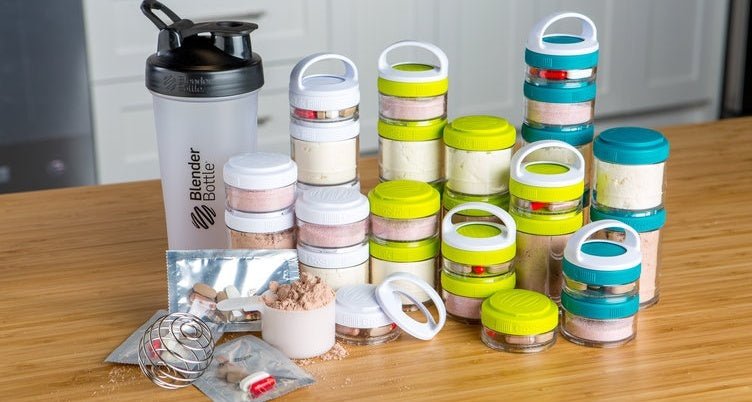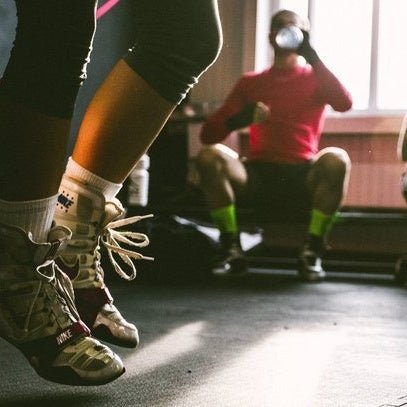From protein powder to real food, get the low-down on this vital macronutrient.
Protein powders, protein supplements, complete proteins, lean proteins everywhere you turn, people are talking, posting, and tweeting about protein. We all know protein is important it's one of those things we simply accept as true. But how many of us have taken the time to understand why? What purpose does protein serve both real food and protein powder? How much do our bodies need, and how can we make sure we get enough of the best protein powders and protein-rich foods? Let's find out.
Why is Protein from Real Food and Protein Powder Important?
Protein has numerous important functions in the body. Our bodies require amino acids, which are organic compounds found in proteins, to function properly 22 of them, to be exact. Of these, we make 13 (the non-essential amino acids) within our bodies; the other nine (the essential amino acids) must come from the protein we consume either from real food or protein powder.
Our organs, muscles, skin, hair, nails, and bones all contain protein. Protein is essential for the growth and repair of tissue and cells, it helps support a healthy functioning immune system, and it plays a role in manufacturing hormones. Simply put, our bodies wouldn't hold up without protein.
For athletes, protein's role in muscle growth and repair is perhaps its most important function. A protein-focused diet is critical for anyone looking to bulk up. If your aim is to lose weight and you're reducing your caloric intake, you still need to consume enough protein to prevent your body from turning to muscle tissue for energy, rather than burning unwanted fat. Even individuals who train purely for improved health and fitness (as opposed to targeted weight loss or muscle gain) should pay attention to protein intake, as it is critical in helping counteract the damage done to muscle fiber during strenuous workouts.
In addition to helping the body burn fat, rather than break down muscle tissue, protein benefits weight loss and weight maintenance efforts in a number of ways. Protein consumption increases the feeling of satiety (fullness), which helps reduce cravings and limit over-eating. Protein also has a higher thermic effect (the calories used to digest and metabolize food) than carbs and fat, which leads to a boost in metabolism. High-protein intake has been linked to reduced belly fat, as well as to long-term prevention of weight regain after weight loss.
Where Can I Find Protein?
We're in agreement, then we all need plenty of protein to function properly, develop and grow, and perform at our best. But where can we find the protein we need? Proteins can be ingested through real foods or protein powders (also known as protein supplements). For many people, a combination of real food and protein powder is the best solution to ensure they consume enough high-quality dietary protein.
Food protein sources that contain all nine essential amino acids in adequate quantities are considered "complete proteins," meaning they contain all nine essential amino acids. It's easy to understand why complete proteins are the best kind. Examples of complete protein real foods include lean meat, fish, eggs, dairy products, quinoa, and chia seeds. Incomplete proteins or proteins that lack some of the nine essential amino acids include legumes, nuts and seeds, vegetables, and grains. Eaten in combination, incomplete proteins can work together to provide all the essential amino acids.
Nutritionally speaking, complete-protein whole foods (or real foods in combination) have more to offer than protein powders. In addition to protein, they provide a wider range of vitamins, minerals, and other nutrients, plus plenty of fiber. It's also tough to match the variety in texture and tastes that real foods provide, as well as the satisfaction of consuming a solid meal to curb hunger.
On the flip side, however, some high-protein whole foods are higher in calories, fat, cholesterol, and sodium than protein supplements. They can also be more time-consuming to prepare and eat, therefore derailing the attempt to consume protein quickly post-workout or during a busy day.
While most experts agree that the majority of our protein should come from a mix of lean protein real food sources, and that it is possible to obtain all of our protein requirements from food, supplementation with protein powders is an easy, efficient, and often quicker-to-digest alternative to solid protein sources.
Protein powders are convenient and beneficial for people who don't have time to prepare complete protein meals, or who want to take their protein to go. And for people who follow vegetarian or vegan diets and may struggle to consume enough protein from whole foods, protein supplements can help increase their intake of high-quality complete proteins. It's important to note that not all protein supplements are complete proteins, however. Whey protein, a milk protein, is a complete protein. So is soy protein the only plant-based complete protein source. Other plant-based protein powders must be combined in order to provide all nine essential amino acids (brown rice protein powder and pea protein powder is one example of a high-quality complete-protein combo).
Shakes containing protein powder can also help reduce your daily caloric intake, therefore aiding in weight loss and weight maintenance. Additionally, protein powder shakes offer convenient healthy nutrition for anyone with a busy schedule.
How Much Protein Do I Need?
There's no single clear answer, as an individual's protein needs vary based on lifestyle, activity level, and fitness goals. The United States Department of Agriculture (USDA) recommends that adults obtain 10-35 percent of total calories from protein, whether from whole foods or protein powders. The Recommended Dietary Allowance (RDA) for protein is 0.8 grams of protein per kilogram of body weight (that's 56 grams daily for the average sedentary man and 46 grams daily for the average sedentary woman). For active adults, protein needs are understandably higher; a commonly recommended, yet broad range is 0.8-1.5 grams per kilogram of body weight. The American College of Sports Medicine recommends 1.0-2.0 grams of protein per kilogram of body weight per day for athletes, depending on training volume and intensity.
There may be reasons to caution against ingesting too much protein or protein powder. Although widely disputed, extremely high protein intake is rumored to be associated with kidney problems, excess weight gain, and other health issues. In reality, these risks are more likely to be related to the source, rather than the volume, of your protein intake (for example, getting the majority of your dietary protein from fatty, highly-processed meat can be an obvious cause for concern). It's possible that any nutrition plan, if taken to an extreme, may result in ill effects ranging from lack of proper nutrient balance to potentially dangerous conditions. Protein intake is critical, however the right amount for you depends on numerous variables. Your best bet, as with any diet plan, is to consult with your doctor or a registered dietician to determine the amount of protein that will healthily support your body and your individual goals.
BlenderBottle's Role in Protein
Ready for some protein? If protein powder is a part of your nutrition plan, you'll need a tool for mixing your protein shakes. That's where BlenderBottle products come into play. Our shaker cups utilize our BlenderBall wire whisk to mix protein supplements and other ingredients into the smoothest shakes imaginable. The leak-proof caps keep your gym bag and car seat dry, making on-the-go protein intake easy and stress free.
Insulated bottles, like the BlenderBottle Strada Stainless Steel, keep drinks cold for up to 24 hours, meaning you can make a protein shake in the morning and it will still taste fresh and cold after your post-work spin class. If you'd rather wait to mix, the BlenderBottle ProStak and BlenderBottle GoStak make it easy to pack your protein powder to go. The BlenderBottle Classic 45, our biggest, beefiest shaker, is meant to curb a monster thirst.
If lighthearted lifting is more your style, BlenderBottle Classic Foodie bottles give your protein supplementation a humorous twist. Our Color of the Month bottles bring a fresh look to your shaker collection, every month. You can even subscribe to our club and have your bottles delivered automatically an easy way to guarantee a monthly boost of motivation to stick with your nutrition plan.
Whatever your style and whatever your appetite, there's a BlenderBottle shaker to perfectly mix your protein powder and accompany you throughout your workout and throughout your day.





Leave a comment
All comments are moderated before being published.
This site is protected by reCAPTCHA and the Google Privacy Policy and Terms of Service apply.